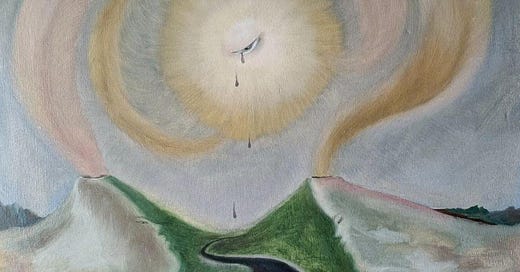For five year old Jada, the Dolomiti is a picturesque backdrop for her first bike ride. This universal coming of age was staged on the neighbour’s steeply sloped property along with a pair of siblings the same age as me. Out of the three of us, I was the only one who didn’t know how to pedal, but this memory is devoid of shame, only trumped by the possibility of steering my training wheels straight off a cliff.
My two-year residency just shy of the Italian-Austrian border in Borca di Cadore is not one I can recall with great confidence– the village had a mere population of 800 people, I went to school twenty minutes away in Cortina, raised tadpoles to frogs in the summer and despised my maths tutor.
In a recent conversation with a friend, we exchanged childhood experiences. Eventually, the conversation shifted, pedalling in the direction of a hyper-specific but vital memory that followed after my first bike ride, and like driving a car out of fog, I felt like I’d unlocked a lost idiosyncrasy and reclaimed a childhood moment I’d long abandoned.
The Spearmint Syrup
The forgotten symbol
“If the Dolomites were a flavour, it would be spearmint.” I said.
“What? I thought you didn’t even like spearmint flavoured things.”
“I detest the stuff,” I affirmed, “five year old Jada would’ve had an aneurism knowing that at 22 she hates spearmint, but latte e menta is the flavour of my childhood summers– the day I learnt how to ride a bike, I gulped down a massive glass of the stuff. I think at one stage my parents had to ban me from milk.”
“What’s the flavour of childhood winter, then?”
“Roasted chestnuts outside the bus stop after school.” How sweet a reminder this was.
The next half of this conversation was like an aftershock from an earthquake– a realisation that was seventeen years slumbering, the shock that I had forgotten what was arguably the apple of my eye circa 2006.
There is a simplicity to childhood. All I cared about was my blessed latte e menta. But the magnitude of this realisation was unnerving– when did simplicity evolve into a more convoluted, ambiguous, chaos-prone and confusing life?
At what point did my childhood cease?
I mourn the naivety of five-year-old me, oblivious to the fact that when she stood on the stepping stool in our kitchen, reached for the bright green syrup and mixed it into a glass of milk, that that would be the last time before she moved continents and grew up.
My tastebuds shifted; I forgot.
Reminiscing on learning how to ride a bike– albeit a cliche memory– helped me reinvigorate multiple memories I’d previously forgotten by noticing the reassurance of iconography against the passage of time.
Some motifs, like latte e menta, perished with age; a melancholy realisation.
The Fireplace and The Snow
A fear of forgetting
It’s common for the liminal space beneath a staircase to house storage cupboards, bookshelves, or the odd reading nook, but one of the things that made our Dolomitian apartment a lighthouse of memory amongst the fog of my childhood was that it was uniquely equipped with a colossal hearth.
Tiled with ceramic, cerulean blue details that I’d trace with my grubby fingers, I would often sit deep in thought within the space where the fireplace stopped and the stairs begun– a nook just small enough for me. My thinking spot. I recall wedging myself there with my childhood blanket (that, admittedly, I still sleep with) and thinking long and hard the first time I saw snow.
Our move to Italy was certainly not of my volition, but there was an indifference (or, a lack of understanding) at the concept of moving countries. It wasn’t hard to convince me.
“Do you want to see snow, Jada?” My parents had asked me before the move, as if to grant some semblance of autonomy, as if I were to hold any responsibility or say in such a decision. Snow was as foreign and elusive as it was fascinating to me, and I looked down at my hands, attempting to imagine how snowflakes could fall between my fingers, how it would feel as soft as the petals from the roses in my mom’s garden.
But, as fate would have it, when we eventually arrived in Italy (much to my family’s horror, I broke my arm in Hong Kong during the three hour layover between Auckland and Rome) there was not a patch of snow to be seen.
“It’s summer, Jada, we need to wait until winter.”
And wait, and wait, and wait I did.
The day I saw snow was my first taste of disappointment. After months of waiting for the weather to turn and for the peaks of the Dolomites to be dusted with white, on that fateful morning when my parents woke me up and told me to look out the window, I was out the door, down the stairs, still in my pyjamas, and launched face first, arms wide, into the snow.
Those months of yearning, of imagining snow to be soft like flour, were instead replaced with the cold, hard onslaught of ice in my face, biting my eyes, filling my nostrils, and bringing me to tears.
I will never forget that stinging sensation. I found myself comparing this memory to my first bike ride and my pure, child-like enjoyment of latte e menta; pleasure seems to be quickly forgotten, pain is unforgettable.
Like the pensive spot between the fireplace and the stairs, are there spaces and moments available to me as a child that have been buried and forgotten?
“Nostalgia Over Moments That No Longer Exist” was actually the title of one of my first ever publications for a quaint student-led magazine when I was sixteen. I submitted an anthology of poems, all saturated with longing for years long past and memories long lived. A yearning against time is a theme that has followed me through my art for many years:
"These are moments that defined my life, the bitter realisation that I will never feel them again, and the fear that they may be forgotten.” I wrote.
In my last newsletter, Chronophobia, nostalgia is presented as a double edged sword; harrowing and comforting, wholesome and confronting, reassuring and terrifying:
“I am afraid! Afraid that if I do not spend my priceless time remembering that the mirage will evolve into a terrifying, barren landscape– one of remorseful, regretful amnesia. For there may come a time when I move to another land and whilst packing my boxes I discover my cursive handwriting obscured and warped, trapped in the dread of a forgotten day, week, month or decade.”
Even my piece Home is Memory is bittersweet:
“The cycle of being born somewhere, living there for most your life then being able to return years later is a comforting experience. In contrast, my history is spread thin across three countries between the Pacific, Atlantic and Indian Oceans, seemingly worlds apart. No amount of knocking can mend the disparity of my identity, especially when every time someone asks me where I am from, it feels like stitches being plucked from my skin.”
“I wasn’t sure if I could grant such a wish. I felt like a museum with a fragmented history; a confused mixed-race emigrant who didn’t know which place to tie her identity to; a girl who didn’t really know where home was.”
Beautiful Reminiscing
Memory, at the risk of being lost, can shift and adapt; a waxing and waning of existence, an ode to fleeting joy. The two week’s I’ve spent writing this newsletter have ejected me out the other end with difficult feelings to process, and here lies my conclusion:
The antithesis of the melancholy of forgetting is the joy of remembrance.
Devoid of forgetfulness and aging, I am comforted by the fact that I am a conscious being that can experience the ups and downs of reminiscing imperfectly and attempting to immortalise my lifetime through art.
These moments do still exist. I walk with them every single day. In the same way the moon fills over the course of a month and is consistently reborn, even if my memories elude and enshroud me, they make me whole, even when it doesn’t seem like it.
And so, with concluding tonight’s newsletter, I’ve raised a sickly green glass to toast not only to my first bike ride and my first snow, but the many memories that remain dormant and ready to be rediscovered.
Or, well that’s what I was hoping. Writing it in that way seems like a cute round circle moment. The reality? I spat it right out, laughing as it dribbled down my chin.
Eclectic Creative is the newsletter to read with your morning coffee or evening tea. Writer and creative freelancer Jada De Luca grapples with a small corner of the internet, shaping it into a celestial creative non-fiction realm that is dedicated to her favourite topics and ever expansive creativity.
If you are interested in art, writing, spirituality, tarot, travel, and books, you are warmly invited to enjoy Eclectic Creative weekly.
About The Writer
Jada De Luca doesn’t go anywhere without her kindle and interprets tarot cards for the spiritually curious. She is a long time writer and in-house collage witch for the Aussie based travel publication Astray, best known for her piece The Writer’s Routine.
Jada tells stories through an eclectic mix of both written and visual narration, creating magical, surreal, and intensely personal landscapes for her audiences.
I am always looking to connect with other artists, writers, and fellow magical moonbeams. If you enjoy my work, I encourage you to save, share, and don’t forget to tag me! (@fujijada)
My Instagram is @fujijada. Art is shared, life is documented, and DM’s are treated as delicately as hand-delivered letters.
For book recommendations and the occasional review, or if you want to read along with me, please refer to my Goodreads.
If you’re curious about my creative services, I am experienced in creative advertising, content creation, copywriting, website design, art direction & surrealist collage art. Peep the website for more info.
The collage artwork that accompanies a lot of my writing here is created by me. Want some art to hang above your altar, stick on your fridge, display in your home or gift to a lover? My enquiries are open!
And if all of the above appeals to you, shoot me an email directly at deluca.jada@gmail.com.
In the meantime,
Lots of love,
Jada









This was so beautiful! I LOVE reminiscing, but I often wonder how good it is for us. The other thing that I often ponder is how some of my memories only exist because I have the physical photos to give them shape and the stories told by parents and grandparents. I wonder if this part of our lives — the admittedly most documented part — will ever feel hazy, or if we’ll always have photos and videos to come back to and verify memories. Thank you for writing this!🥰